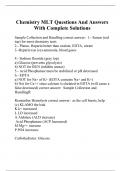-
1. Exam (elaborations) - Clinical chemistry ii- bun/uric acid questions with complete solutions
-
2. Exam (elaborations) - Clinical chemistry terms questions with complete solutions
-
3. Exam (elaborations) - Introduction to clinical chemistry questions with complete solutions.
-
4. Exam (elaborations) - Chemistry mlt questions and answers with complete solutions
-
5. Exam (elaborations) - Clinical chemistry compre questions with complete solutions.
-
6. Exam (elaborations) - Vet tech clinical chemistry questions with complete solutions
-
7. Exam (elaborations) - Elsevier: clinical chemistry questions with complete solutions
-
8. Exam (elaborations) - Clinical chemistry mlt| 142 questions| with complete solutions
-
9. Exam (elaborations) - Michael bishop clinical chemistry - electrolytes clinical significance questions with...
-
10. Exam (elaborations) - Mlt clinical chemistry final| 200 questions | with complete solutions
-
11. Exam (elaborations) - Clinical chemistry: instrumentation questions with complete solutions
-
12. Exam (elaborations) - Michael bishop clinical chemistry - enzymes (ck) questions with complete solutions
-
13. Exam (elaborations) - Clinical chemistry theory (mlt) questions with complete solutions
-
14. Exam (elaborations) - Clinical chemistry – apollon| 121questions| with complete solutions
-
15. Exam (elaborations) - Clinical chemistry 2 questions with complete solutions
-
16. Exam (elaborations) - Clinical chemistry exam 5 questions with complete solutions
-
17. Exam (elaborations) - Clinical chemistry - elsevier and boc| 215 questions| with complete solutions
-
18. Exam (elaborations) - Clinical chemistry exam| 226 questions| with complete solutions
-
19. Exam (elaborations) - Clinical chemistry practice set questions with complete solutions
-
20. Exam (elaborations) - Clinical chemistry recalls questions with complete solutions
-
21. Exam (elaborations) - Michael bishop clinical chemistry – electrolytes questions with complete solutions
-
22. Exam (elaborations) - Mlt clinical chemistry test 2 questions with complete solutions
-
23. Exam (elaborations) - Week 1 clinical chemistry ch. 1-3 questions with complete solutions
-
24. Exam (elaborations) - Clinical chemistry (analytical methods) questions with complete solutions
-
25. Exam (elaborations) - Clinical chemistry study guide questions with complete solutions
-
26. Exam (elaborations) - Clinical chemistry final (mls)| 124 questions| with complete solutions
-
27. Exam (elaborations) - Clinical microbiology mlt| 121 questions| with complete solutions
-
28. Exam (elaborations) - Mlt 230 : clinical chemistry, unit 1 questions with complete solutions
-
29. Exam (elaborations) - Mlt clinical chemistry: lipids and lipoproteins questions with complete solutions
-
30. Exam (elaborations) - Clinical chemistry lecture - clinical laboratory supplies questions with complete sol...
-
31. Exam (elaborations) - Clinical chemistry practice questions with complete solutions
-
32. Exam (elaborations) - Clinical chemistry 2 - acp and alp laboratory questions with complete solutions
-
33. Exam (elaborations) - Clinical chemistry-tdm questions with complete solutions
-
34. Exam (elaborations) - Clinical chemistry exam 1 & (book chapters 1,2,3,4 review questions) with complete so...
-
35. Exam (elaborations) - Clinical chemistry study exam questions with complete solutions.
-
36. Exam (elaborations) - Clinical chemistry review| 342 questions | with complete solutions
-
37. Exam (elaborations) - Clinical chemistry final exam review| 351 questions | with complete solutions
-
38. Exam (elaborations) - Clinical chemistry (clinical chemistry, blood gases, electrolytes, toxicology) questi...
-
39. Exam (elaborations) - Basic clinical chemistry questions with complete solutions.
-
40. Exam (elaborations) - Clinical chemistry mlt| 113 questions| with complete solutions
-
41. Exam (elaborations) - Clinical chemistry practice exam| 228 questions | with complete solutions
-
42. Exam (elaborations) - Clinical chemistry exam questions with complete solutions
-
43. Exam (elaborations) - Clinical laboratory exam mcqs| 585 questions| with complete solutions
-
44. Exam (elaborations) - Boc clinical chemistry questions with complete solutions
-
45. Exam (elaborations) - Clinical chemistry i ascp review| 467 questions| with complete solutions
-
46. Exam (elaborations) - Clinical chemistry exam 1 questions with complete solutions
-
47. Exam (elaborations) - Mlt clinical chemistry final review| 100 questions| with complete solutions
-
48. Exam (elaborations) - Clinical chemistry exam| 104 questions | with complete solutions
-
49. Exam (elaborations) - Chemistry mlt questions with complete solutions
-
50. Exam (elaborations) - Harr: clinical chemistry questions and answers with complete solutions
-
51. Exam (elaborations) - Clinical chemistry practice exam questions with complete solutions
-
52. Exam (elaborations) - Mlt chemistry questions and answers with complete solutions
-
53. Exam (elaborations) - Bishop: clinical chemistry| 420 questions | with complete solutions
-
Show more




